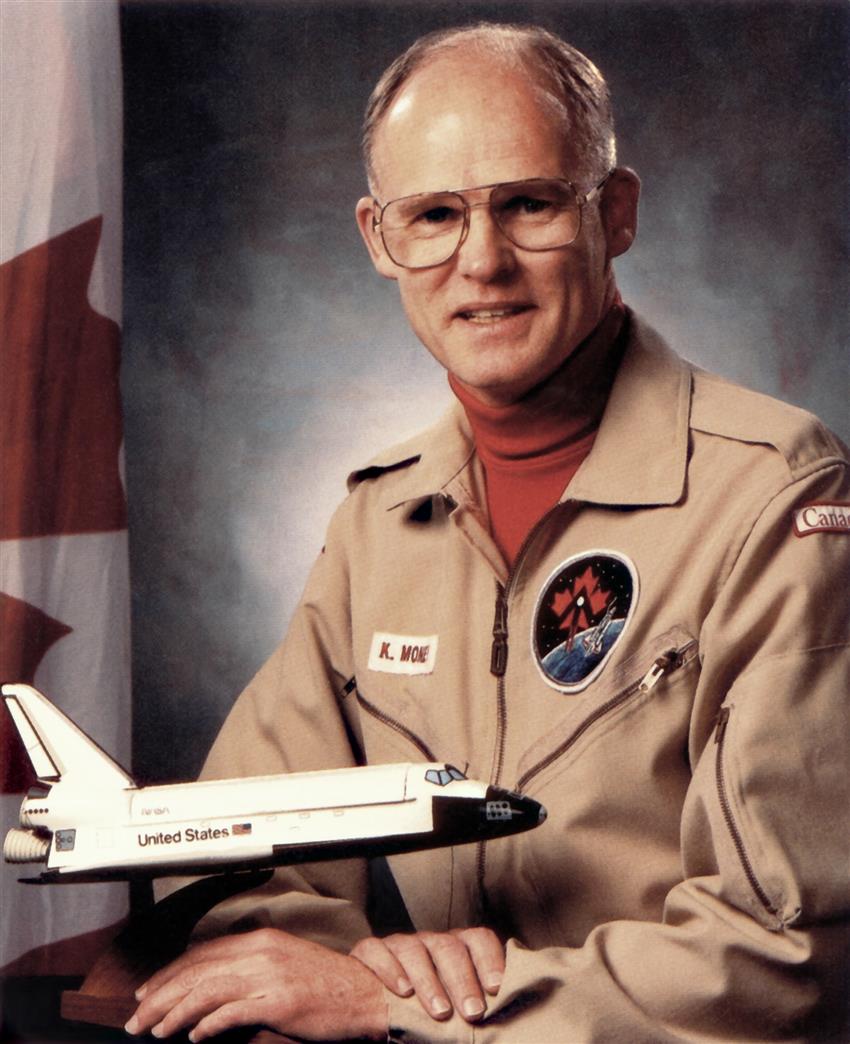Biography of Ken Money

Canadian Space Agency (CSA) astronaut Ken Money. (Credit: CSA)
- Date of birth:
- From: Toronto, Ontario, Canada
- Background: Physiology professor, lecturer, scientist, Olympian
- Education: Bachelor of science in physiology and chemistry, master of science in physiology, Ph.D. in physiology
- Language: English
- Mission: None
Personal information: Dr. Ken Money was married with one daughter. He liked to ski, skydive, fish, read and play bridge and badminton. As an accomplished athlete, he represented Canada in the Summer Olympics in Melbourne, Australia, where he placed in the top five of the men's high-jump competition.
Special honours: Dr. Money was the W. Rupert Turnbull lecturer, Canadian Aeronautics and Space Institute in . He was elected an Academician of the International Academy of Astronautics in . In , Dr. Money was awarded a fellowship in the U.S. Aerospace Medical Association. He received the Wilbur R. Franks Award in from the Canadian Society of Aviation Medicine for his contributions to aviation medicine. He was awarded the Grass Foundation Neurosciences Lectureship, Penn State University, in . He was the Wellmark Lecturer for the Canadian Association for Clinical Microbiology and Infectious Diseases in . The same year he was inducted into the University of Toronto's Hall of Fame for his swimming and track and field achievements. In , Dr. Money was awarded the Meritorious Service Cross by the Governor General of Canada for his many contributions to science and technology. He was presented with the Kent Gillingham Award by the U.S. Aerospace Medical Association in for his contributions to knowledge of disorientation and situational awareness in flight.
Experience: Dr. Money was a former Royal Canadian Air Force fighter pilot who flew a wide variety of aircraft, including bush planes and helicopters. On two occasions, he piloted successful search and rescue missions in Canada's northern wilderness using float-equipped Otter aircraft. His passion for flight extended to his interest and involvement in acrobatic flying.
Dr. Money graduated from the National Defence College in and from the Accelerated Free Fall Skydiving course at the Spaceland Parachute Center in Houston in . He was an associate professor of physiology (part time) at the University of Toronto and lectured regularly to undergraduate classes. Dr. Money also taught occasionally at York University and gave talks at universities in Canada, the United States, Great Britain, France, Italy and Japan. A believer in lifelong learning, he completed community college courses in accounting and management disciplines. He served as editor and co-author of the report that looked at the potential psychological and physiological aspects on astronauts involved in long-duration spaceflight missions.
As a physiologist, Dr. Money made significant contributions to the knowledge of the inner ear, motion sickness, pilot disorientation, biological effects of spaceflight, effects of alcohol and other areas of science. He was recognized for having invented and demonstrated semicircular canal plugging, an experimental surgical operation used in North American and European hospitals to treat specific types of dizziness. Over the years, Dr. Money published 110 scientific articles and authored six different topics for the World Book Encyclopedia and one for Microsoft Encarta.
Dr. Money was first and foremost a scientist, having made substantial contributions to the fields of vestibular physiology and aviation medicine. In , he embarked on a career with the Defence and Civil Institute of Environmental Medicine (DCIEM), now known as Defence Research and Development Canada (DRDC), in Toronto, Ontario. He developed expertise on motion sickness in human spaceflight while also closely studying spatial disorientation in pilot flight.
Dr. Money first worked with the NASA space program in and acted as a scientific advisor to the U.S. agency. He was a co-investigator on a range of experiments on six Space Shuttle missions.
Astronaut experience: Dr. Money was a member of Canada's original astronaut corps, selected in . He began his astronaut training in . Later that year, Dr. Money launched Canada's initial medical experiments performed in space when the first Canadian astronaut flew aboard Mission STS-41G.
In early , Dr. Money was designated alternate payload specialist for the first International Microgravity Laboratory mission, Space Shuttle Discovery flight STS-42, that took place in . As Spacelab payload operations controller for this life sciences mission that investigated microgravity and its effects on the human body in space, he coordinated communications between the flight crew and the ground support team from NASA's Marshall Space Flight Center in Huntsville, Alabama. He also helped formulate numerous space physiology experiments for the Spacelab IML-1 mission to explore the root causes of space sickness.
After nearly a decade as an astronaut, Dr. Money left the CSA in to return to his passion of studying and practising physiology.
He worked for six years as a corporate director on the board of Interquest Incorporated, a Toronto company that finances technology start-up companies. Dr. Money served on the board's audit committee and also chaired the compensation committee. For three years, he worked on the board of directors and on the science advisory board of Lifetech Corporation, a Toronto-area biotech firm.
Dr. Money retired as senior scientist at DRDC, where he first began his career.
Ken Money passed away at the age of 88.
Explore further
- Date modified:
